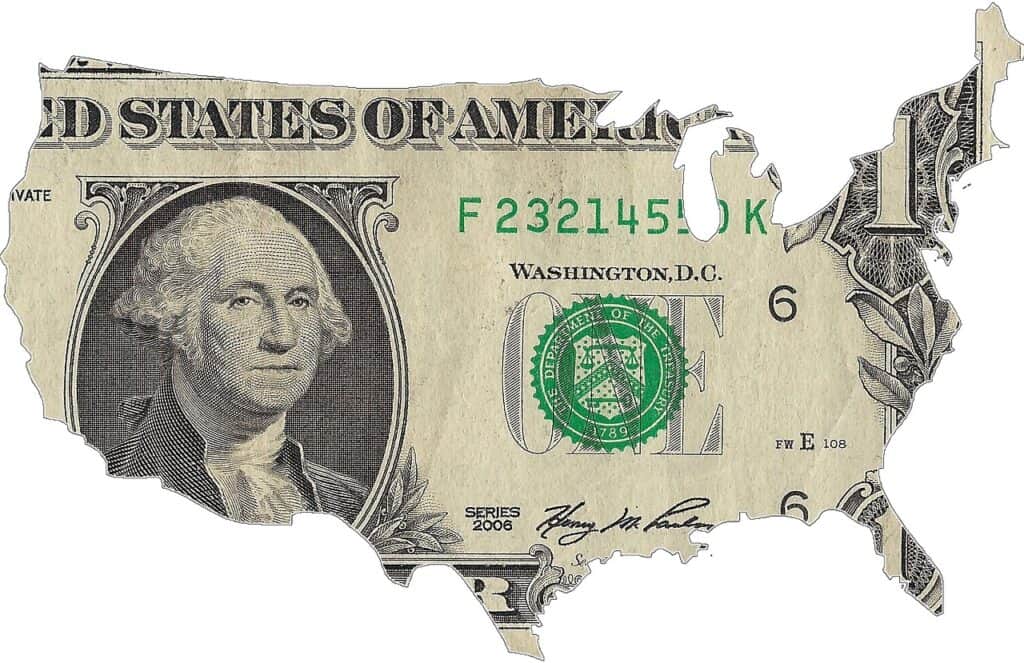Peak interest rates, a presidential election, and geopolitical uncertainty — 2024 is already primed to be another potential shapeshifter. Questions remain about inflation, interest rates, housing prices, investment portfolios, and conflicts abroad. As the strong economy moderates and the path of interest rates comes down, here are the 10 2024 financial trends we have our eye on.

#1. Inflation’s downward trend
Inflation hit 3.1% in November, higher than the Federal Reserve’s 2% target, but lower than last year’s 6.5%. Steady declines have experts hopeful that inflation has peaked and will trend downward to the 2-3% range by December 2024.
Slowing price gains are supported by factors like a less frantic labor market, rising unemployment, and slow-moving housing market changes. The Fed’s recent rate hike pause suggests that the Fed is also eyeballing lower inflation next year. (More on that below.)
Still, lower inflation isn’t guaranteed. Volatile energy prices, sticky wages, and pessimistic consumer expectations could all see high inflation stick around longer. With the recent Red Sea conflicts that affect almost a quarter of global shipping, we could see further disruptions that keep inflation a bit stickier than expected.
#2. Less consumer spending
We also expect disinflation to be driven by decreased consumer spending in 2024.
Despite experts highlighting “healthier” household balance sheets, 61% of people still live paycheck-to-paycheck. And just because inflation is slowing doesn’t mean today’s higher prices will go away (or that wages have kept pace).
Already, consumers are sinking increasingly-large percentages of their paychecks into housing, food, and healthcare costs. (Not to mention new pressures like restarting student loan payments and an uptick in household debt and related delinquencies.)
Taken together, this data suggests that declining consumer spending will contribute to lower inflation in 2024.
#3. A slightly better housing market (for buyers)
It’s no secret that the housing market went crazy post-pandemic. Skyrocketing home prices and mortgage rates, tighter lending restrictions, and lackluster inventory have pushed homeownership dreams out of reach for many.
It’s unlikely that 2024 won’t reverse these trends entirely. However, reprieve could sit on the horizon, as experts predict the year could see:
- Mortgage rates decline to near 6.5%
- Home prices drop 0.2-2%
- Higher inventory (due in part to higher interest rates slowing sales)
These indicators may not spur a buyer’s market, but they may spark a moderate increase in affordability and home sales. (Already, we’re seeing a shift as more sellers negotiate lower prices and offer concessions than in previous years.)

#4. Shrinking economic growth
The U.S. experienced 2.4-2.8% GDP growth in 2023, surprising many who’d predicted a sharp economic decline. (GDP, or gross domestic product, assigns a dollar value to an economy’s goods and service output. Examining changing GDP provides a way to measure an economy’s health.)
2023’s unexpected growth prevented the economy from entering a recession. However, changing financial circumstances could slow 2024’s growth to a crawl. Exact predictions vary widely from 0.7% to 2.1%, depending on:
- The effectiveness of Federal Reserve interest rate hikes
- The impact of depleted stimulus
- How student loan repayments weigh on consumer budgets
- Rising consumer debt and delinquency trends
- Labor market changes
- Turbulence in the housing market
#5. Falling interest rates
The Federal Reserve declined to hike interest rates in its last two meetings, and even signaled that 2023 could see a 0.75% rate cut.
However, many Wall Street banks have predicted that the Fed’s outlook is underly or overly rose. Some see rate cuts coming harder and faster, dropping 2-3% in 2023. Others forecast that the Fed will take its time, lowering rates over 2-3 years.
The Fed’s exact actions will be informed by the always-precarious balance of growth and recession. Cutting rates prematurely could see inflation roar back, necessitating a return to rate hikes. Conversely, moving too slowly could sink spending, spiking unemployment and kickstarting a recession.
#6. Recession risks: Short and shallow or “slow then grow”
Market consensus seems to be that the Fed has managed to execute the notoriously-tricky “soft landing” in 2024. (That is, reducing inflation without plunging the U.S. into recession.) As of late 2023, the combination of rate hikes and quantitative tightening has slowed growth while preventing drastic disinflation.
Now they have to stick the landing.
We expect some turbulence in 2024 financial trends, and a short, shallow recession isn’t out of the question. Some experts peg the odds at 50%, while Goldman Sachs has reaffirmed its 15% stance. (Incidentally, 15% is the average recession risk at any time.)
Barring recession, 2024 could also be the year of “slow then grow.” This theory predicts a slower “transition period” in early 2024, followed by more sustainable, less volatile growth as the economy finds its footing.

#7. Less turbulent real asset prices
Recent years triggered outsize volatility in “real assets” – tangible products like real estate, precious metals, commodities, and natural resources.
Some of these, especially commercial real estate, metals, and certain agricultural products, experienced a turbulent 2023 thanks to:
- Geopolitical uncertainty
- A slowdown in global manufacturing
- Rising interest rates
- Waning corporate profits
Others, like energy and farmland, enjoyed higher prices and more stable demand resulting from international unrest and resource competition.
In 2024, many real assets are poised for greater success. Oil prices may benefit from social-political disruption and production cuts in high-production regions. Farmland and commercial real estate prices and activity could lift under declining interest rates. And as the U.S. dollar wanes, gold prices are expected to set new record highs.
#8. A return to “normal” investing strategies
The post-pandemic markets enticed investors to try new, often riskier strategies. Stock picking, “meme stocks,” NFTs, and cryptos all gained popularity. Last year’s rate hikes and 5%+ savings rates also spurred a $1.1 trillion increase in cash holdings. But as the hype (and interest rates) die down, 2024 could usher in more “normal” investing trends.
To start, bonds’ attractive 5-8% yields offer passive income and long-term downside protection for bondholders. And though stock investors enjoyed surprising upside in 2023, 2024 could introduce wariness around recession, interest rate, and inflation uncertainty. (Though many investors predict a banner year thanks to elevated prices, high earning expectations, and a comfortable inflationary environment.)
The combination of high bond yields and more appropriate risk tolerances may even see 60/40 portfolios return. (60% stocks, 40% bonds.) While this buy-and-hold tactic probably won’t outperform in 2024, a more balanced, diversified strategy could reintroduced stability into investors’ portfolios.
#9. Funds and themes abound
Alongside better risk-adjusted investments, 2024 financial trends could also encourage more fund-based strategies. ETFs and index funds, which “bundle” and parcel shares of many individual assets, may retake their popularity over riskier stock-picking methods. There’s also evidence that investors will welcome alternative growth strategies using theme-based strategies like ESG and SRI.

#10. “more” Mainstream Crypto
Crypto has finally gone mainstream with the January 2024 approval of Bitcoin ETFs that could drive further investment flows. Along with the Bitcoin halving event this year, which highlights the scarcity of the digital asset, crypto enthusiasts are optimistic about performance.
Walking the tightrope of uncertainty in 2024 financial trends
While we have our eye on these 2024 financial trends, we’re also leaving room for nuance and change.
Geopolitical tensions remain top of mind, as elevated trade tensions, the Russia-Ukraine war, and conflict in the Middle East present unsolved uncertainties. There’s also room for opportunities, perhaps in markets like Japan, Asia’s best performing market of 2023. (or just take advantage of the weak yen and travel there in style!)
At home, beyond offering abundant headlines, the presidential election may be mildly positive for markets as policymakers try to stay on the right side of voters.
To weather volatility, the best strategic approach is to build a long-term plan. Prioritize managing your finances, and you’ll start to see meaningful change.

